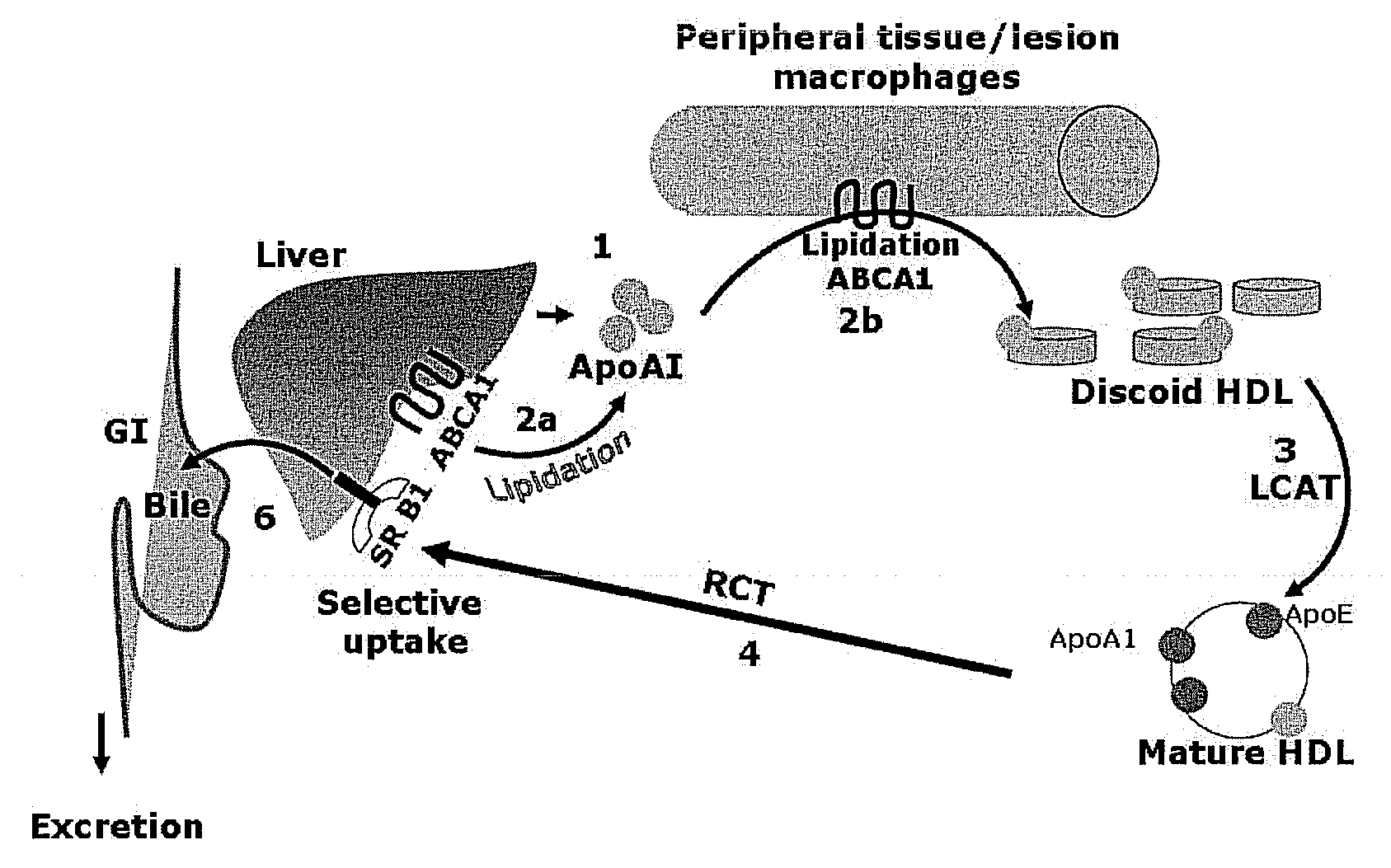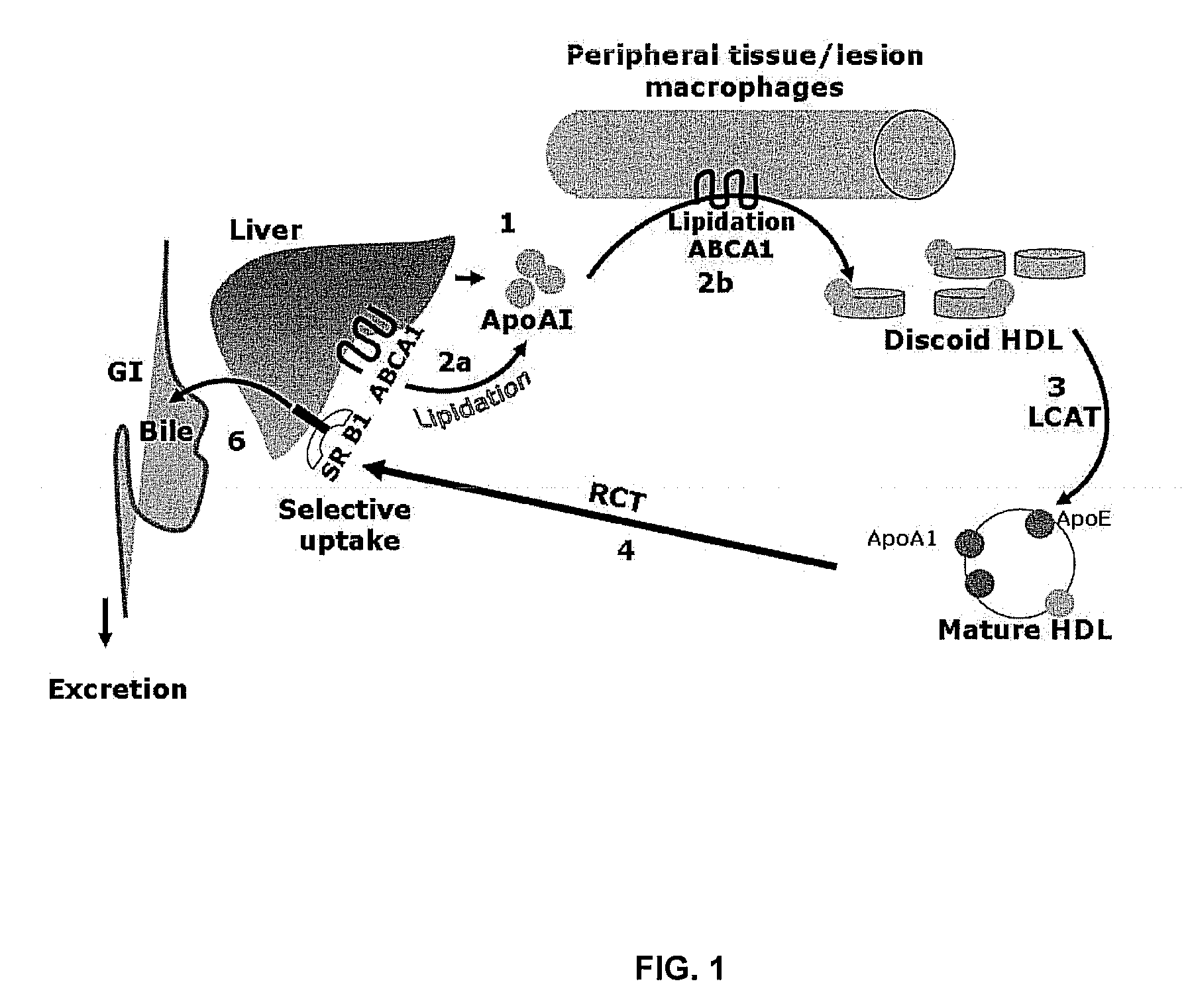Compositions and methods to enhance reverse cholesterol transport
- Summary
- Abstract
- Description
- Claims
- Application Information
AI Technical Summary
Problems solved by technology
Method used
Image
Examples
example 1
[0083]This example illustrates the effect of compound A on HDL and the ABCA1, SR-B1 and LCAT genes associated with RCT in LDL-receptor (LDLr) null mice in a short term model.
[0084]Eight-weeks-old LDLr mice (Jackson Laboratories, Bar Harbor, Me.), were used for this Example. Mice were distributed into two groups of 8 mice each. One group received vehicle containing carboxymethyl cellulose and Tween-80 (Sigma Chemical Co.), and the other group received a daily dose of compound A at 25 mg / kg.
[0085]After one week, plasma samples were collected and used for HDL determination. Mice were euthanized by CO2, and aorta and liver samples were collected for RNA isolation.
[0086]Next, liver and aorta samples from vehicle and compound A treated mice were removed, flash frozen in liquid nitrogen and subsequently used for RNA isolation. Tissues were lysed in 600 uL lysis buffer (Qiagen) and placed in the TissueLyser (Qiagen) for 3 minutes. Samples were then processed using the RNeasy mini kit (liver...
example 2
[0087]This example illustrates the effect of compound A on genes associated with RCT in HepG2 cells.
[0088]Human HepG2 cells were cultured in DMEM containing 4500 mg glucose / L (ATCC) supplemented with 10% fetal bovine serum (FBS), penicillin (100 U / ml), and streptomycin (100 μg / ml) in a humidified atmosphere (5% CO2 in air) at 37° C. Cells were plated onto 12 well dishes and cultured in low serum (0.5% FBS) for experiments. Cells were treated with either vehicle (DMSO) or the test compound overnight and used for RNA isolation. Briefly, cells were lysed in 300 uL of lysis buffer (Qiagen) and placed in the TissueLyser (Qiagen) for 3 minutes. Samples were then processed as described by the RNeasy mini kit. RNA was then verified and quantified using the Agilent RNA 600 Nano Assay Labchip® system, and real time PCR was performed to quantitate gene expression using validated primer sets from SuperArray. The results were illustrated in FIGS. 8-9.
example 3
[0089]This example illustrates the effect of compound A on HDL and atherosclerosis in LDLr null mice in a long term model.
[0090]Eight-weeks-old LDLr null mice (Jackson Laboratories, Bar Harbor, Me.), were used for these studies. Two groups of 8 mice each received a Western Diet (Research Diet incorporated, New Brunswick, N.J.; D12079B containing 0.1% cholesterol) for 2 weeks. Plasma samples were collected and used for lipid analysis. Mice were then distributed into two groups, one group received vehicle containing carboxymethyl cellulose and Tween-80 (Sigma Chemical Co.), and the other group received a daily dose of compound A at 25 mg / kg. Both groups were continued on the Western Diet for another 16 weeks. At the end of the 16 weeks, the mice were euthanized by CO2, and whole aortas (from aortic sinus to the beginning of iliac aorta) were isolated, and fixed in 10% paraformaldehyde. The aortas were then opened and stained with Sudan IV solution for 30 minutes. Images of whole aorta...
PUM
| Property | Measurement | Unit |
|---|---|---|
| Molecular weight | aaaaa | aaaaa |
| Transport properties | aaaaa | aaaaa |
Abstract
Description
Claims
Application Information
 Login to View More
Login to View More - R&D
- Intellectual Property
- Life Sciences
- Materials
- Tech Scout
- Unparalleled Data Quality
- Higher Quality Content
- 60% Fewer Hallucinations
Browse by: Latest US Patents, China's latest patents, Technical Efficacy Thesaurus, Application Domain, Technology Topic, Popular Technical Reports.
© 2025 PatSnap. All rights reserved.Legal|Privacy policy|Modern Slavery Act Transparency Statement|Sitemap|About US| Contact US: help@patsnap.com



